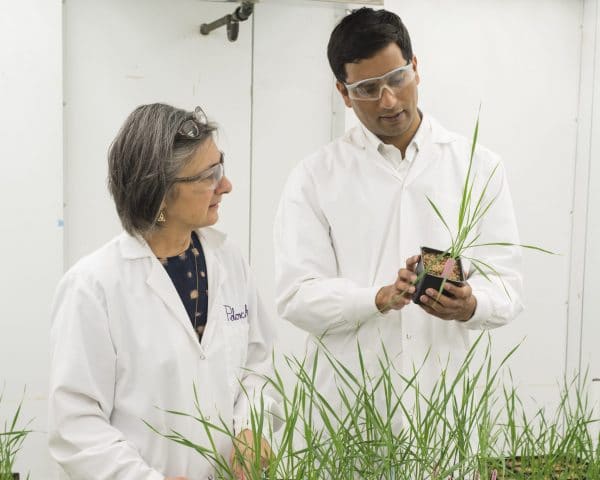One of the most time-consuming parts of the crop breeding process is the time needed to grow successive generations of plants. What if we could really speed that up?
That’s the goal of a project at the National Research Council of Canada (NRC). The accelerated growth methods used in this project could potentially trim several years off the breeding process, providing a big boost to the development of improved crop varieties.
“The project’s overall aim is to speed up plant growth so breeders can achieve multiple generations of the crop in a very short time,” explains Dr. Kishore Rajagopalan with the NRC in Saskatoon, who is leading the project. “That will help greatly with plant breeding efforts because plants take quite some time to grow and you need to go through several generations as part of a breeding program.”
For instance, imagine the challenge for a breeder who is trying to address an urgent threat, like a very virulent new strain of a major pathogen. “Sometimes it can take 10 to 13 years to get new varieties out into the marketplace. Pathogens can evolve quickly and spread around the world. They don’t sit around and wait for the breeders to catch up with them. So the faster that the breeders can introduce new forms of disease resistance into a crop, the better,” notes Dr. Patricia Polowick, another NRC researcher involved in accelerated growth studies.
“Accelerated breeding is faster than traditional crop breeding. So if farmers are faced with new threats whether from disease or other means, improved varieties will get to the farmers much faster and they won’t have as much crop loss.”
Acceleration Options
In his project, Rajagopalan’s team is applying multiple methods to speed up wheat growth and looking for the best combination of these methods that will take the plants from seed to flowering and maturity in the shortest time.
One intriguing method involves growing plants under constant light. “The use of continuous light for accelerating crop growth was adopted initially by a group of Australian researchers in collaboration with others around the world. They were inspired by experiments conducted by NASA [National Aeronautics and Space Administration] in the 1980s and 1990s looking at growing plants in controlled environmental conditions including constant light,” Rajagopalan says.
The NASA scientists were experimenting with the use of plants to help maintain human life in space. “In these experiments, they observed a linear effect of light on photosynthetic rate and production of plant biomass. In simple terms, photosynthesis is the process by which a plant converts atmospheric carbon dioxide into storable sugars using energy that comes from sunlight, and in the process it emits oxygen back into the atmosphere. [The scientists observed that] if you increase the supply of light to the plant, then it continues to perform photosynthesis and continues to grow more and faster and produce more biomass,” he notes.
“In addition, in certain plants, especially in cereal crops like wheat and barley, applying continuous light also seems to increase the plant’s development rate. So the plant goes from seed to flowering faster, and you get to the next generation of plants faster. This is simply because constant light could act as a stress factor. When you apply stress to a plant, the plant responds by producing flowers and seeds, and completing its lifecycle as early as possible before it dies or desiccates.”
Rajagopalan notes other environmental stress factors can also accelerate plant development in a similar way. So, along with constant light, the project is testing factors like moisture stress, nutrient availability stress and stress from smaller pot sizes.
The research team is also using a propagation method called embryo rescue to go more quickly from one generation to the next. “We harvest seeds before they are fully mature and dried, and harvest the embryos from these grains, put the embryos on nutrient media plates and get seedlings from them. That can save us a few weeks, instead of waiting for the grains to mature and dry,” Rajagopalan explains.
Speed Breeding, Canadian Style
The project’s four objectives mainly relate to determining optimal procedures for accelerating growth of Canadian wheats, seeing how many generations they can get per year, and increasing understanding of the effects of these accelerated growth conditions on plants.
“The first objective is to evaluate the rust and Fusarium head blight resistance of different Canadian wheat varieties when grown under normal conditions compared with the accelerated growth conditions,” says Rajagopalan. “We want to understand how important traits like disease resistance are affected by these accelerated growth conditions so that we can use these conditions for breeding for those traits.”
They are focusing on Fusarium head blight and rust because of the relevance of these diseases to Canadian wheat production. “We looked at Fusarium head blight because it’s an increasing problem in the wheat-growing regions in Western Canada. The statistics from the last 10 years show the incidence of Fusarium head blight in wheat in Canada has increased almost every year; 2016 was a particularly bad year. Not only does this disease reduce yields but it can also produce toxins, like deoxynivalenol (DON), which can downgrade grain quality and affect the marketability of the grain. So it’s a pretty devastating disease economically,” he says.
“That’s why many researchers here at the NRC and in other organizations are working to find new sources of resistance against Fusarium head blight in wheat. And we want to be able to quickly deploy those novel traits into varieties that are being created, so those varieties can respond to this increasing threat in Canadian farming. By using accelerated breeding, we believe we can bring these traits to the market earlier than is currently possible.”
Like Fusarium head blight, rust is a major disease concern in Prairie wheat crops, and many Canadian researchers are working on rust resistance. Rajagopalan’s project is targeting leaf rust, a common disease in wheat. Under conditions that favour this disease, susceptible wheat varieties can suffer very serious yield losses. Over the years, several leaf rust resistance genes have been introduced into Canadian wheat cultivars and then the pathogen has evolved to defeat that resistance.
“Rapid deployment of new rust resistance genes is essential for fighting this pathogen. And again, speed breeding would be the way to address that.”
The project’s second objective is to see if responses to the accelerated growth methods vary among different wheat varieties. This extensive work involves testing multiple Canadian varieties of bread wheat and durum wheat and determining which combination of acceleration methods is best for each cultivar. “We want to see if we can do any tailoring of conditions for particular varieties,” notes Rajagopalan.
The third objective is to rapidly generate a recombinant inbred line population under accelerated growth conditions. Such lines are very useful for mapping traits in a plant’s genome. The lines generated in Rajagopalan’s project will be used in other projects to characterize resistance genes for rust diseases in wheat.
“And the fourth objective is to evaluate long-term changes induced when plants are grown for multiple generations under accelerated growth conditions,” says Rajagopalan. “We want to see if any long-lasting effects are happening in the plants compared to plants grown under normal conditions.”
Polowick adds, “One of the reasons we want to look at the long-term effects is because we are putting the plants under a lot of stress.” Breeders will want to be sure plants grown under induced stresses to accelerate their growth will respond to things like diseases and insect pests in the same way when they are grown under normal conditions.
Boosting a Breeding Revolution
This two-year project started in April 2017, and Rajagopalan’s team has already completed two of the objectives. “We have completed the testing of the effects of Fusariumand rust resistance in different varieties under normal and accelerated growth conditions. And we have completed the very large-scale study to understand the effects of accelerated growth conditions on various wheat varieties. So we have a really good understanding of what conditions work best for the multiple varieties of durum and bread wheat that we have tested.” The researchers are currently working on the other two objectives.
The effects of the accelerated growth conditions are very impressive so far.
“Right now, we are getting about five to six generations of wheat within a year using these conditions. For plants grown under normal conditions [in a greenhouse], you will get around two to three generations per year. So you can reduce the generation time of the plant by half by adopting these conditions,” says Rajagopalan.
There is already interest in applying speed breeding beyond Rajagopalan’s project. “I’m running a parallel study with a private breeding company using the same accelerated breeding ideas with some of their wheat lines,” Polowick explains. “This concept has been heavily adopted by the plant breeding industry in places like Australia, and we’re hoping that some of our work here will make it more available to the Canadian breeders so Canadian farmers can benefit from our progress.”
Along with the benefit of bringing new varieties to the market sooner, Polowick points to a further advantage. “Some of the other projects within the NRC [and other agencies] use the modern ‘omics’ such as genomics and proteomics, and these technologies have enabled great progress in the identification of novel plant traits whether it is to fight diseases or to mitigate the effects of environmental stresses. So it’s not accelerated growth conditions in isolation; it’s accelerated growth in combination with a lot of the progress being made in other projects that will provide the most benefit to the farmers.”
Alberta Wheat Commission research manager Lauren Comin sees value in this type of research. “Decreasing the time it takes for a variety to be developed is very important for producers. Producers need to be able to be nimble when it comes to choosing a variety. For example, resistance to abiotic and biotic stress plays an important role in selection. We are seeing pests adapt over time and currently employed resistance genes are being defeated. At the same time, we are seeing remarkable advancements in pre-breeding and discoveries of new sources of resistance. Shorter variety development times mean that new genes can be deployed and be in a farmer’s field without too much of a lag. Our scientists can respond to changes more quickly, which allows farmers to adapt faster as well.”
Along with the potential for large, rapid steps forward in Canadian wheat varietal improvement, other crops could also benefit from the powerful combination of accelerated breeding and valuable new traits. Australian research shows speed breeding can also work in such crops as barley, chickpea, pea and canola, with the number of possible generations per year depending on the crop type.
“We would love to see wider adoption of these accelerated breeding methods that we are working on in Canadian wheat breeding programs and to also make progress in other crops where this approach is applicable,” Rajagopalan says.
His project is funded by the Saskatchewan Ministry of Agriculture, the Canada-Saskatchewan Growing Forward 2 program, and the National Research Council of Canada.





